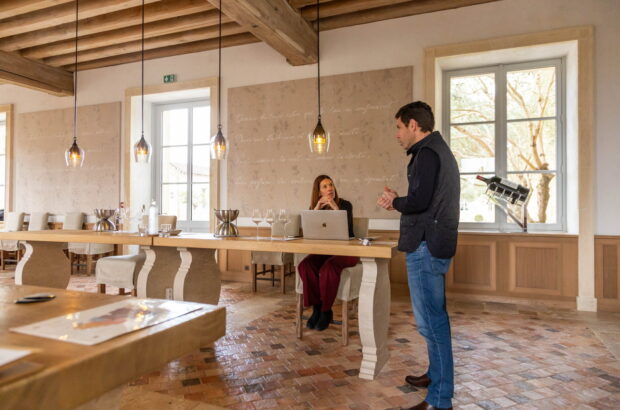Surreal is a word you sometimes see used to describe the vineyards of the Canary Islands. And it’s true there’s something uncanny, almost nightmarish about, say, a vineyard trained with the traditional cordon trenzado method in El Valle de la Orotava on the archipelago’s largest island of Tenerife.
Arranged horizontally just inches above the ground, the gnarled, plaited vines, many of them well over a century old, some as much as 200 years old, seem to slither around the vineyards like entwined wooden snakes, stretching as far as 15m from the mother trunk – a sight made all the more eerie when shrouded in the mist that is such a frequent feature of this sub-tropical climate.
No less peculiar, surprising and dreamlike are the vineyards of Lanzarote, which call to mind some imagined post-apocalyptic experiment to make wine on the moon. Here the vines are dug into the thick layer of pícon volcanic ash that covers the island, each bush vine protected from the winds that blow in off the Atlantic by being planted in pits (hoyos) surrounded by low semi-circular stone walls (abrigos or overcoats).
So yes, surreal, but very far from irrational. The vineyards look like they do because they’ve been adapted to the very specific challenges of their surroundings by generations of ingenious wine growers. That their radical difference comes as a shock to those of us weaned on the conventions of modern mainland European viticulture is largely due to the fact that the Canary Islands have been away from the vinous mainstream for so long.
That’s not surprising. Strictly – geographically – speaking, the seven islands that collectively form Europe’s most southerly wine region are part of Africa: clustered, at 28° latitude, on the southern border of the Northern Hemisphere’s traditional band of winemaking possibility, with the southwestern Moroccan Atlantic coast just 96km from the southeastern coast of Fuerteventura. Culturally and politically, however, this is Spain of course, and has been since the islands were colonised and settled in the late 15th century.
{"content":"PC9wPgo8aDI+Q2FuYXJpZXMgYW5kIEJhbGVhcmljcyBMaXRlcmFyeSBwYXN0PC9oMj4KPHA+V2l0aCB0aGUgU3BhbmlhcmRzIGFuZCBQb3J0dWd1ZXNlICh3aG8gZ2F2ZSB1cCB0aGVpciBjbGFpbSBvbiB0aGUgQ2FuYXJpZXMgaW4gZXhjaGFuZ2UgZm9yIHRoZSBTcGFuaXNoIGxlYXZpbmcgTWFkZWlyYSwgdGhlIEF6b3JlcyBhbmQgQ2FwZSBWZXJkZSB0byB0aGVtKSBjYW1lIHRoZSB2aW5lLCBhbmQgdGhlIGlzbGFuZHPigJkgZmlyc3QgYnJ1c2ggd2l0aCB2aW5vdXMgZmFtZS4gQ2FuYXJ5IElzbGFuZCB3aW5lcywgdGhhbmtzIGluIG5vIHNtYWxsIHBhcnQgdG8gdGhlIGlzbGFuZHPigJkgaWRlYWwgcG9zaXRpb24gb24gdHJhbnNhdGxhbnRpYyB0cmFkZSByb3V0ZXMsIHdlcmUgbXVjaCBjb3ZldGVkIGluIEVsaXphYmV0aGFuIEVuZ2xhbmQuIFJlZmVyZW5jZXMgdG8g4oCYY2FuYXJ5IHNhY2vigJkgYWJvdW5kIGluIFNoYWtlc3BlYXJlIHBsYXlzIOKAkyBmcm9tIOKAmGEgY3VwIG9mIGNhbmFyeeKAmSBpbiA8ZW0+VHdlbGZ0aCBOaWdodDwvZW0+IHRvIHRoZSDigJhtYXJ2ZWxvdXMgc2VhcmNoaW5nIHdpbmXigJkgdGhhdCDigJhwZXJmdW1lcyB0aGUgYmxvb2TigJkgaW4gPGVtPkhlbnJ5IElWIFBhcnQgSUk8L2VtPi4gTGF0ZXIsIFRob21hcyBKZWZmZXJzb24gaXMgc2FpZCB0byBoYXZlIGFza2VkIGZvciBhIENhbmFyeSBJc2xhbmQgd2luZSB0byB0b2FzdCB0aGUgc2lnbmluZyBvZiB0aGUgRGVjbGFyYXRpb24gb2YgSW5kZXBlbmRlbmNlIGluIDE3NzYuPC9wPgo8cD5CeSB0aGUgMjB0aCBjZW50dXJ5LCBob3dldmVyLCBDYW5hcnkgSXNsYW5kIHdpbmVzIGhhZCBkd2luZGxlZCBpbnRvIGEgbGFyZ2VseSBwYXJvY2hpYWwgY29uY2Vybi4gSXTigJlzIHN0cmlraW5nIHRoYXQsIGluIHRoZSBtb3N0IHJlY2VudCBlZGl0aW9uIG9mIDxlbT5UaGUgT3hmb3JkIENvbXBhbmlvbiB0byBXaW5lPC9lbT4sIHRoZSBicmllZiBlbnRyeSBvbiB0aGUgQ2FuYXJ5IElzbGFuZHMgKHdyaXR0ZW4gYnkgcmVzcGVjdGVkIFNwYW5pc2ggd2luZSBleHBlcnQgVmljdG9yIGRlIGxhIFNlcm5hKSBkZXNjcmliZXMgaG93IOKAmG1lZGlvY3JlIHdpbmVzIGZvciB0aGUgdG91cmlzdCB0cmFkZSBhcmUgYmVpbmcgcmVwbGFjZWQgYnkgbXVjaCBtb3JlIGludGVyZXN0aW5nIHByb2R1Y3Rz4oCZLjwvcD4KPGRpdiBjbGFzcz0iYWQtY29udGFpbmVyIGFkLWNvbnRhaW5lci0tbW9iaWxlIj48ZGl2IGlkPSJwb3N0LWlubGluZS0zIiBjbGFzcz0iaXBjLWFkdmVydCI+PC9kaXY+PC9kaXY+CjxwPkhvbGlkYXltYWtlcnMgYXNpZGUsIGZvciBtb3N0IHdpbmUgZHJpbmtlcnMgb3V0c2lkZSB0aGUgaXNsYW5kcywgZXZlbiB0aG9zZSDigJhtZWRpb2NyZeKAmSB3aW5lcyB3ZXJlIGEgbXlzdGVyeS4gSXTigJlzIHJlYWxseSBvbmx5IGluIHRoZSBwYXN0IGRlY2FkZSB0aGF0IHRoZSBDYW5hcnkgSXNsYW5kcyBoYXZlIGJlZ3VuIHRvIG1ha2UgYW55IHNvcnQgb2YgbWFyayBvbiB0aGUgbW9kZXJuIGludGVybmF0aW9uYWwgd2luZSBzY2VuZS4gQnV0IGl04oCZcyB0aGUgaXNsYW5kc+KAmSB2ZXJ5IGlzb2xhdGlvbiB0aGF0IGhhcyBtYWRlIHRoYXQgcmVuYWlzc2FuY2UgcG9zc2libGUg4oCTIGFuZCBzbyBleGNpdGluZy48L3A+CjxwPkl0IHdhcyB0aGUgYXJjaGlwZWxhZ2\/igJlzIHJlbW90ZSBnZW9ncmFwaGljYWwgcG9zaXRpb24sIGFmdGVyIGFsbCwgdGhhdCBtZWFudCB0aGUgQ2FuYXJpZXMgYXZvaWRlZCB0aGUgcGh5bGxveGVyYSBwbGFndWUgdGhhdCBzd2VwdCB0aHJvdWdoIEV1cm9wZSBpbiB0aGUgbGF0ZSAxOXRoIGFuZCBlYXJseSAyMHRoIGNlbnR1cnkuIFRoYXQgaW4gdHVybiBtZWFudCB0aGVyZSB3YXMgbm8gbmVlZCB0byBhcHBseSB0aGUgY3VyZTogcmF0aGVyIHRoYW4gcmVwbGFjaW5nIHZpbmV5YXJkcyByYXZhZ2VkIGJ5IHRoZSBsb3VzZSB3aXRoIHBsYW50cyBncmFmdGVkIG9uIHRvIEFtZXJpY2FuIHJvb3RzdG9ja3MsIENhbmFyeSBJc2xhbmRlcnMgaGF2ZSBiZWVuIGFibGUgdG8ga2VlcCB2aW5lcyBvbiB0aGVpciBvd24gcm9vdHN0b2NrcyAocGllIGZyYW5jbykuPC9wPgo8ZGl2IGNsYXNzPSJhZC1jb250YWluZXIgYWQtY29udGFpbmVyLS1tb2JpbGUiPjxkaXYgaWQ9InBvc3QtaW5saW5lLTQiIGNsYXNzPSJpcGMtYWR2ZXJ0Ij48L2Rpdj48L2Rpdj4KPHA+VGhlIGFic2VuY2Ugb2YgcGh5bGxveGVyYSBhbHNvIGFjY291bnRzIGZvciB0aGUgcmVtYXJrYWJsZSBhZ2Ugb2YgbWFueSBDYW5hcnkgSXNsYW5kIHZpbmVzLCBhbmQgZm9yIHRoZSBpc2xhbmRz4oCZIGRlZmlhbnRseSBlY2NlbnRyaWMgcG9ydGZvbGlvIG9mIGdyYXBlIHZhcmlldGllcy48L3A+CjxoMj5Mb2NhbCB2YXJpZXR5PC9oMj4KPHA+T24gdGhlIHdoaXRlIHNpZGUsIE1hbHZhc2lhIHdhcyBoaXN0b3JpY2FsbHkgY29uc2lkZXJlZCB0aGUgbW9zdCBpbXBvcnRhbnQsIHRoZSBpbmdyZWRpZW50IG9mIHRoZSBzd2VldCBzYWNrIHRoYXQgbWFkZSB0aGUgYXJjaGlwZWxhZ2\/igJlzIG5hbWUgKGFsdGhvdWdoIHJlY2VudCBldmlkZW5jZSBzdWdnZXN0cyB0aGUgd2luZXMgbWF5IHdlbGwgaGF2ZSBiZWVuIGJsZW5kcykuIEl0IGlzIHN0aWxsIHdpZGVseSBwbGFudGVkLCBub3RhYmx5IG9uIGJvdGggTGEgUGFsbWEgYW5kIExhbnphcm90ZSwgcHJvZHVjaW5nIGJvdGggZHJ5IHdpbmVzIGluIGFuIGFycmF5IG9mIHN0eWxlcyBhbmQgcXVhbGl0eSwgYW5kIHN3ZWV0IHdpbmVzIHRoYXQgcmVmZXJlbmNlIHRoZSBvbGQgZGF5cyAoYW5kIG9jY2FzaW9uYWxseSBoaXQgYSB0YW5neS1sdXNpY2lvdXMgc3dlZXQgc3BvdCkuIE1hbHZhc2lhIGlzIGpvaW5lZCBieSBMaXN0w6FuIEJsYW5jbyAodGhlIGxvY2FsIG5hbWUgZm9yIHNoZXJyeSBjb3VudHJ54oCZcyBQYWxvbWlubyBGaW5vKSwgYW5kIFZpamFyaWVnbyBCbGFuY28gKG9uY2UgY29tbW9uIGluIEFuZGFsdWNpYSwgbm93IGNvbmZpbmVkIHRvIHRoZSBDYW5hcmllcywgYW5kIHRvIFRlbmVyaWZlIGFuZCBFbCBIaWVycm8gaW4gcGFydGljdWxhcik7IGFzIHdlbGwgYXMgTWFybWFqdWVsbyBhbmQgR3VhbCAodGhlIGxvY2FsIG5hbWUgZm9yIE1hZGVpcmHigJlzIEJ1YWwpIGFtb25nIG90aGVycy48L3A+CjxkaXYgY2xhc3M9ImFkLWNvbnRhaW5lciBhZC1jb250YWluZXItLW1vYmlsZSI+PGRpdiBpZD0icG9zdC1pbmxpbmUtNSIgY2xhc3M9ImlwYy1hZHZlcnQiPjwvZGl2PjwvZGl2Pgo8cD5Gb3IgcmVkcywgYW5vdGhlciBNYWRlaXJhbiBmYXZvdXJpdGUsIFRpbnRhIE5lZ3JhIE1vbGUgKGtub3duIGluIHRoZSBDYW5hcmllcyBhcyBOZWdyYW1vbGwpLCB0aGUgUG9ydHVndWVzZSB2YXJpZXR5IEFsZnJvY2hlaXJvIGFuZCBKdXJh4oCZcyBUcm91c3NlYXUgKGdvaW5nIGJ5IHRoZSBsb2NhbCBzeW5vbnltcyBCYWJvc28gTmVncm8gYW5kIFRpbnRpbGxhLCByZXNwZWN0aXZlbHkpIGFyZSBqb2luZWQgYnkgVmlqYXJpZWdvIE5lZ3JvIChDYXRhbG9uaWHigJlzIFN1bW9sbCkgYW5kIHRoZSBzb2xvIHN0YXIgb3IgbWFpbiBwbGF5ZXIgaW4gbWFueSBvZiB0aGUgQ2FuYXJpZXPigJkgbW9zdCBjcml0aWNhbGx5IGFjY2xhaW1lZCByZWRzOiBMaXN0w6FuIE5lZ3JvLjwvcD4KPHA+V2l0aCBDYW5hcnkgSXNsYW5kIHdpbmVzIGl04oCZcyBub3Qgc28gbXVjaCB0aGUgZ3JhcGUgdmFyaWV0aWVzIHRoZW1zZWx2ZXMgYXMgdGhlIHdheSB0aGV5IGludGVyYWN0IHdpdGggdGhlIGFyY2hpcGVsYWdv4oCZcyB1bmlxdWUgY29uZGl0aW9ucyB0aGF0LCBsaXRlcmFsbHksIGdldHMgdGhlIG1vdXRoIHdhdGVyaW5nLiBCcm9hZGx5IHNwZWFraW5nLCB0aGUgY2xpbWF0ZSBpcyBzdWItdHJvcGljYWwsIHdpdGggdGhlIGZpZXJjZSBoZWF0IG9mIFNhaGFyYW4gQWZyaWNhIG1vZGVyYXRlZCBieSB0aGUgY29vbGluZyBlZmZlY3RzIG9mIEF0bGFudGljIHRyYWRlIHdpbmRzLCBsZWFkaW5nIHRvIHdhcm0gc3VtbWVycyBhbmQgbWlsZCB3aW50ZXJzLjwvcD4KPHA+SG93ZXZlciwgdGhlcmUgYXJlIG1hbnkgZGlmZmVyZW50IG1pY3JvY2xpbWF0ZXMgb24gZWFjaCBpc2xhbmQuIE9uIHRoZSBsYXJnZXN0IGlzbGFuZCBvZiBUZW5lcmlmZSBhbG9uZSB5b3UgY2FuIGZpbmQgZW5vcm1vdXMgdmFyaWF0aW9ucyBkZWZpbmVkIGJ5IHRoZSB2YXJ5aW5nIGFsdGl0dWRlcyBhbmQgZXhwb3NpdGlvbnMgb24gdGhlIHNsb3BlcyBvZiBFbCBUZWlkZSwgYW4gYWN0aXZlIHZvbGNhbm8gdGhhdCwgYXQgMyw3MThtIGFib3ZlIHNlYSBsZXZlbCwgaXMgU3BhaW7igJlzIGhpZ2hlc3QgcGVhay4gVGhlc2UgZGlmZmVyZW5jZXMgYXJlIHJlZmxlY3RlZCBpbiBUZW5lcmlmZeKAmXMgZml2ZSBET3MgKGZyb20gdGhlIGRyeSwgc291dGhlcm4gQWJvbmEsIHdpdGggcGxhbnRpbmdzIHRvdWNoaW5nIDEsNTAwbSBhYm92ZSBzZWEgbGV2ZWwsIHRoZSBoaWdoZXN0IGluIEV1cm9wZSwgdG8gdGhlIG1vcmUgaHVtaWQgWWNvZGVuLURhdXRlLUlzb3JhLCBvbiB0aGUgaXNsYW5k4oCZcyBub3J0aHdlc3Qgc2lkZSkuPC9wPgo8cD5UaGVyZSBpcyBjb3JyZXNwb25kaW5nIHZhcmlldHkgaW4gdGhlIHdpbmUgc3R5bGUsIHRvbywgYWx0aG91Z2ggYXQgdGhpcyBzdGFnZSBpbiB0aGUgQ2FuYXJ5IElzbGFuZHPigJkgZXZvbHV0aW9uIGl0IGlzbuKAmXQgYWx3YXlzIGVhc3kgdG8gc2F5IGhvdyBtdWNoIGlzIGRvd24gdG8gdGVycm9pciBhbmQgaG93IG11Y2ggdG8gaW5kaXZpZHVhbCB3aW5lbWFraW5nIHBoaWxvc29waGllcy4gSW4gZ2VuZXJhbCwgaG93ZXZlciwgQ2FuYXJ5IElzbGFuZCB3aW5lcyBhcmUgY2F0ZWdvcmlzZWQgYnkgYSB3aWxkbmVzcyBvZiBmbGF2b3VyIHRoYXQgc2hvdWxkbuKAmXQgYmUgY29uZnVzZWQgd2l0aCBydXN0aWNpdHk6IGEgbWl4IG9mIGVsZWN0cmljIGFjaWRpdHkgYW5kIHNhbHRpbmVzcywgYW5kIGEgbGlnaHRuZXNzIG9mIGFsY29ob2wgdGhhdCBtYWtlcyB0aGVtIHZlcnkgcmVmcmVzaGluZywgYW5kIHZlcnkgb2YgdGhlIG1vbWVudC48L3A+CjxwPldoaWxlIHRoZXnigJlyZSBlbnRpcmVseSB0aGVpciBvd24gdGhpbmcsIGFzIGEgZnJhbWUgb2YgcmVmZXJlbmNlLCB0aGUgcmVkcyBvZnRlbiBoYXZlIHNvbWV0aGluZyBvZiBFdG5h4oCZcyBOZXJlbGxvIE1hc2NhbGVzZSBhYm91dCB0aGVtOiBhIGtpbmQgb2YgUGlub3QgTm9pci1saWtlIGdyYWNlIGFuZCByZWQtZnJ1aXRlZCBzdXBwbGVuZXNzIGNoYXJnZWQgd2l0aCBwZXBwZXJ5IHNwaWNlLCBlYXJ0aCBhbmQgaXJvbi1saWtlIG1pbmVyYWxzLiBNZWFud2hpbGUgaW4gdGhlaXIgbWl4IG9mIGludGVuc2l0eSwgdGFuZyBhbmQgemlwLCB0aGUgd2hpdGUgd2luZXMgYXJlIGhvdyBJIGltYWdpbmUgdW5mb3J0aWZpZWQgTWFkZWlyYSB3b3VsZCB0YXN0ZS4gTm90IGV2ZXJ5dGhpbmcg4oCTIG5vdCBuZWFybHkgZW5vdWdoLCBpbiBmYWN0IOKAkyByZWFjaGVzIHRoZSBVSy4gQnV0IHRoZXNlIGRlbGljaW91c2x5IGlkaW9zeW5jcmF0aWMgd2luZXMgYXJlIHdvcnRoIGdldHRpbmcgdG8ga25vdyB3aGVuIHlvdSBmaW5kIHRoZW0uPC9wPgo8aDI+QmFsZWFyaWMgYmVhdDwvaDI+CjxwPklmIHRoZSBDYW5hcnkgSXNsYW5kc+KAmSBtb2Rlcm4tdHJhZGl0aW9uYWwgd2luZXMgYXJlIGEgdHJ1ZSBleHByZXNzaW9uIG9mIHZvbGNhbmljLCBBdGxhbnRpYyB0ZXJyb2lyLCB0aGVuIFNwYWlu4oCZcyBvdGhlciBncmVhdCByZW5haXNzYW5jZSBpc2xhbmQgd2luZXMsIGZyb20gdGhlIEJhbGVhcmljcywgYXJlIGFsbCBhYm91dCB0aGUgZmxhdm91cnMgYW5kIGNoYXJtcyBvZiB0aGUgTWVkaXRlcnJhbmVhbi48L3A+CjxwPldoZW4gd2Ugc2F5IEJhbGVhcmljcyDigJMgYW5kIGNlcnRhaW5seSB3aGVuIHdl4oCZcmUgdGFsa2luZyBhYm91dCB3aW5lcyBhdmFpbGFibGUgaW4gdGhlIFVLIGFuZCBVUyDigJMgd2UgcmVhbGx5IG1lYW4gb25lIGlzbGFuZC4gQWx0aG91Z2ggdGhlcmUgaXMgYSBzbWFsbCBidXQgZ3Jvd2luZyBhbmQgaW5jcmVhc2luZ2x5IGludGVyZXN0aW5nIHNjZW5lIG9uIE1lbm9yY2EsIGFuZCBhIHNwcmlua2xpbmcgb2YgdmVudHVyZXMgb24gSWJpemEgYW5kIEZvcm1lbnRlcmEsIHRoZSBoZWFydCBvZiB0aGUgYWN0aW9uIGluIHRoZSBhcmNoaXBlbGFnbyB0aGF0IGJlZ2lucyA5NmttIGVhc3Qgb2YgU3BhaW4sIGlzIGluIE1hbGxvcmNhLiBXaXRoIGFyb3VuZCAyLDUwMGhhIG9mIHZpbmV5YXJkcyBpdCBpcyBob21lIHRvIHRoZSBCYWxlYXJpYyBJc2xhbmRz4oCZIHR3byBvZmZpY2lhbGx5IHJlY29nbmlzZWQgRE9zLCBCaW5pc3NhbGVtIGFuZCBQbGEgaSBMbGV2YW50LCBhcyB3ZWxsIGFzIHR3byByZWdpb25hbCB3aW5lIGRlc2lnbmF0aW9ucyBhbmQgc29tZSA3MCBwcm9kdWNlcnMuPC9wPgo8cD5XaW5lIGFycml2ZWQgaW4gTWFsbG9yY2Egd2l0aCB0aGUgUm9tYW5zLCBidXQgbGlrZSB0aGUgQ2FuYXJ5IElzbGFuZHMsIGl0IHdhcyBhcyBhIHByb2R1Y2VyIG9mIE1hbHZhc2lhIHNhY2sgaW4gdGhlIDE2dGggY2VudHVyeSB0aGF0IGl0IGZpcnN0IGNhbWUgdG8gZmFtZS4gVW5saWtlIHRoZSBDYW5hcmllcywgaG93ZXZlciwgdGhlIHZpbmV5YXJkcyBvZiBNYWxsb3JjYSBmZWxsIHZpY3RpbSB0byBwaHlsbG94ZXJhLCB3aGljaCBjYW1lIHRvIHRoZSBCYWxlYXJpY3MgaW4gMTg5MSwgYW5kIHdoaWNoLCBieSB0aGUgdGltZSBpdCBmaW5pc2hlZCBpdHMgd29yaywgaGFkIGRlc3Ryb3llZCB0aGUgbG9jYWwgd2luZSBpbmR1c3RyeS48L3A+CjxwPlRoZSByZWNvdmVyeSB3YXMgc2xvdyB0byBjb21lLiBGYXJtZXJzIHF1aXQgdGhlIHdpbmUgYnVzaW5lc3MgaW4gZmF2b3VyIG9mIG90aGVyIGZvcm1zIG9mIGFncmljdWx0dXJlIChhbG1vbmQgdHJlZXMgYmVpbmcgYSBwYXJ0aWN1bGFybHkgcG9wdWxhciBjaG9pY2UpLCBhbmQgd2hlcmUgdmluZXMgd2VyZSByZXBsYW50ZWQsIG9mdGVuIHdpdGggYSBjby1wbGFudGVkLCBpbnRlcm1pbmdsaW5nIG1peCBvZiB2YXJpZXRpZXMgYm90aCByZWQgYW5kIHdoaXRlLCBpdCB3YXMgc3RyaWN0bHkgZm9yIGxvY2FsIGNvbnN1bXB0aW9uLiBCeSB0aGUgMTk4MHMsIGhvd2V2ZXIsIGEgaGFuZGZ1bCBvZiBncm93ZXJzIGhhZCBzdGFydGVkIHRha2luZyBwcm9kdWN0aW9uIG1vcmUgc2VyaW91c2x5LCBzcHJ1Y2luZyB1cCBjZWxsYXJzIHdpdGggbW9kZXJuIGVxdWlwbWVudCBhbmQgcGxhbnRpbmcgdmluZXMuIEFuZCBieSAxOTkwLCBCaW5pc3NhbGVtLCBpbiB0aGUgY2VudHJlIG9mIHRoZSBpc2xhbmQsIGhhZCBiZWNvbWUgU3BhaW7igJlzIGZpcnN0IGlzbGFuZCB3aW5lIERPLiBOb3cgaW50ZXJlc3QgaW4gTWFsbG9yY2FuIHdpbmUgYmVjYW1lIG1vcmUgdGhhbiBhIG1lcmUgdG91cmlzdC1pbnNwaXJlZCBjdXJpb3NpdHkuPC9wPgo8cD5BcyB3aXRoIHNvIG1hbnkgb3RoZXIgKHJlLSlkZXZlbG9waW5nIFNwYW5pc2gg4oCTIGFuZCwgaW5kZWVkLCBzb3V0aGVybiBFdXJvcGVhbiDigJMgd2luZSByZWdpb25zLCBpbnRlcm5hdGlvbmFsIGdyYXBlIHZhcmlldGllcyBwbGF5ZWQgYSBtYWpvciByb2xlIGluIHRoZSBsYXRlIDIwdGgtY2VudHVyeSBleHBhbnNpb24gb2YgdGhlIE1hbGxvcmNhbiB2aW5leWFyZC4gQ2FiZXJuZXQgU2F1dmlnbm9uLCBTeXJhaCwgTWVybG90LCBQaW5vdCBOb2lyIGFuZCBDaGFyZG9ubmF5IGFyZSBhbGwgZm91bmQgaW4gdmFyeWluZyBxdWFudGl0aWVzIGFyb3VuZCB0aGUgaXNsYW5kLCBhcyB3ZWxsIGFzIDxhIGhyZWY9Imh0dHBzOi8vd3d3LmRlY2FudGVyLmNvbS93aW5lL2dyYXBlLXZhcmlldGllcy90ZW1wcmFuaWxsby10aW50by1maW5vLyI+VGVtcHJhbmlsbG88L2E+LCBrbm93biBieSBpdHMgQ2F0YWxhbiBzeW5vbnltIChpc2xhbmRlcnMgc3BlYWsgYSBkaWFsZWN0IG9mIENhdGFsYW4pIFVsbCBkZSBMbGVicmUsIE1vbmFzdHJlbGwgKGFrYSBNb3VydsOoZHJlKSBhbmQgdGhlIENhdmEgZ3JhcGVzIE1hY2FiZXUgYW5kIFBhcmVsbGFkYS4gQnV0IGl0IGlzIHRoZSBsb2NhbCBncmFwZSB2YXJpZXRpZXMg4oCTIHZpbmlmaWVkIHNlcGFyYXRlbHkgb3IgYXMgcGFydCBvZiBhIGJsZW5kIOKAkyB0aGF0IHByb2R1Y2UgdGhlIG1vc3QgZGlzdGluY3RpdmUgd2luZXMuPC9wPgo8cD5Gb3IgcmVkcywgdGhlcmUgYXJlIHRocmVlIHRoYXQgc3RhbmQgb3V0OiBNYW50byBOZWdybywgd2hpY2ggb24gaXRzIG93biBwcm9kdWNlcyBhIGxpZ2h0LCBqdWljeSwgc3VjY3VsZW50IHN0eWxlIGZvciByZWxhdGl2ZWx5IGVhcmx5IGRyaW5raW5nOyBGb2dvbmV1LCB3aXRoIGl0cyBkaXN0aW5jdGl2ZSBmcmVzaG5lc3MgYW5kIGxvdyBwSDsgYW5kIENhbGxldCwgYSBkYXJrLXNraW5uZWQgZ3JhcGUgd2l0aCBhbiBpbnRyaWd1aW5nIHNwaWNpbmVzcy4gRm9yIHdoaXRlcywgdGhlIGRvbWluYW50IOKAkyBtb3N0IHdpZGVseSBwbGFudGVkIOKAkyBsb2NhbCBpcyBNb2xsLCBvciBQcmVuc2FsIEJsYW5jLCB3aGljaCBvbiBpdHMgb3duIHByb2R1Y2VzIFZlcmRpY2NoaW8tZXNxdWUgd2luZXMgb2YgY3Jpc3AgYnJpc2tuZXNzIHdpdGggYW4gYWxtb25keSB0d2lzdCwgYW5kIHdoaWNoIGhhcyB0aGUgbmF0dXJhbCBhY2lkaXR5IHRvIHNlcnZlIGFzIGEgYmFzZSBmb3Igc29tZSBvZiB0aGUgaXNsYW5k4oCZcyBDYXZhLWxpa2Ugc3BhcmtsaW5nIHdpbmVzLjwvcD4KPGRpdiBjbGFzcz0iaW5qZWN0aW9uIj48L2Rpdj4KPHA+TW9zdCB3aW5lcmllcyBhcmUgc3RpbGwgdXNpbmcgdGhvc2UgbmF0aXZlIGdyYXBlcyBpbiBibGVuZHMgdGhhdCBpbmNsdWRlIGJvdGggbG9jYWwgYW5kIGludGVybmF0aW9uYWwgdmFyaWV0aWVzLiBCdXQsIGFzIHdpdGggdGhlIHdpbmVzIG9mIHRoZSBDYW5hcmllcywgaXTigJlzIHRoZSBpc2xhbmQgY2xpbWF0ZSByYXRoZXIgdGhhbiB0aGUgdmFyaWV0aWVzIHBlciBzZSB0aGF0IG1ha2VzIE1hbGxvcmNhbiB3aW5lcyBzdWNoIGFuIGVuZ2FnaW5nIHByb3Bvc2l0aW9uLiBUaGUgaW5mbHVlbmNlIG9mIHRoZSBzZWEsIHdpdGggYSBjb25zaXN0ZW50IHNlYSBicmVlemUgdGhhdCByZWFjaGVzIGZhciBpbmxhbmQsIGhhcyBhIGRpc3RpbmN0bHkgbW9kZXJhdGluZywgY29vbGluZyBlZmZlY3QuIFRoZSB3aW5lcyBhcmUgY29uc2VxdWVudGx5IG11Y2ggbGlnaHRlciB0aGFuIHRoZWlyIG1haW5sYW5kIE1lZGl0ZXJyYW5lYW4gcGVlcnMg4oCTIHRoZSBCb3JkZWF1eCB2YXJpZXRpZXMgZG8gdmVyeSB3ZWxsIGhlcmUsIHdpdGggbGl0dGxlIGluIHRoZSB3YXkgb2YgZXhjZXNzIGphbW1pbmVzcyDigJMgd2l0aCBhIGRpc3RpbmN0aXZlIHR3aXN0IG9mIHNhbHQtZWRnZWQgZnJlc2huZXNzIHRoYXQgZ2l2ZXMgbGlmZSBhbmQgZHJpbmthYmlsaXR5IGZyb20gZXZlcnl0aGluZyB0byBmaXNoLXBhcnRuZXJpbmcgYmxhbmMgZGUgbm9pciB3aGl0ZXMgdG8gdGhlIG1lYXRpZXN0IG9mIHJlZCBibGVuZHMuPC9wPgo8cD4K"}
The Canaries and Balearics Wines
{}
{"wineId":"39314","displayCase":"standard","paywall":true}
{"wineId":"39315","displayCase":"standard","paywall":true}
{"wineId":"39316","displayCase":"standard","paywall":true}
{"wineId":"39317","displayCase":"standard","paywall":true}
{"wineId":"39318","displayCase":"standard","paywall":true}
{"wineId":"39319","displayCase":"standard","paywall":true}
{"wineId":"39320","displayCase":"standard","paywall":true}
{"wineId":"39321","displayCase":"standard","paywall":true}
{"wineId":"39322","displayCase":"standard","paywall":true}
{"wineId":"39323","displayCase":"standard","paywall":true}
{}











